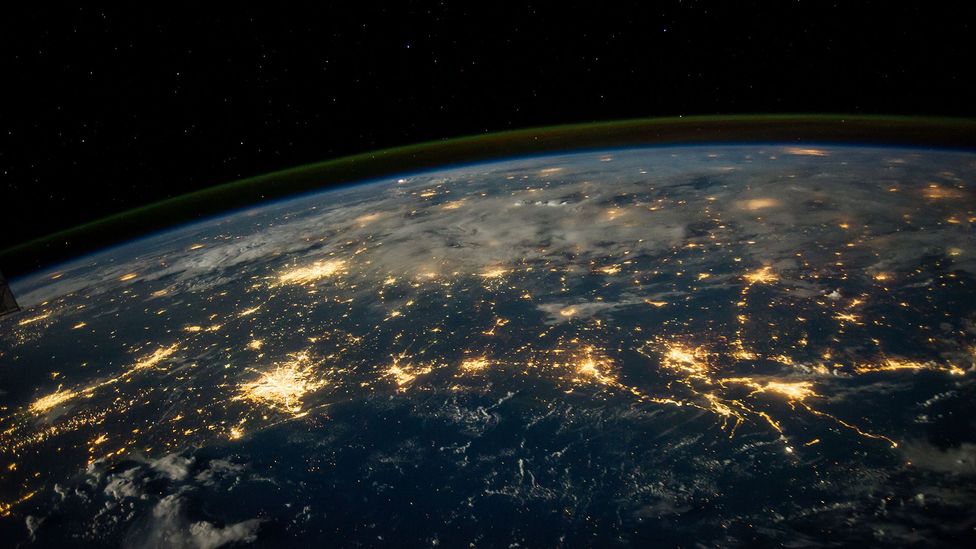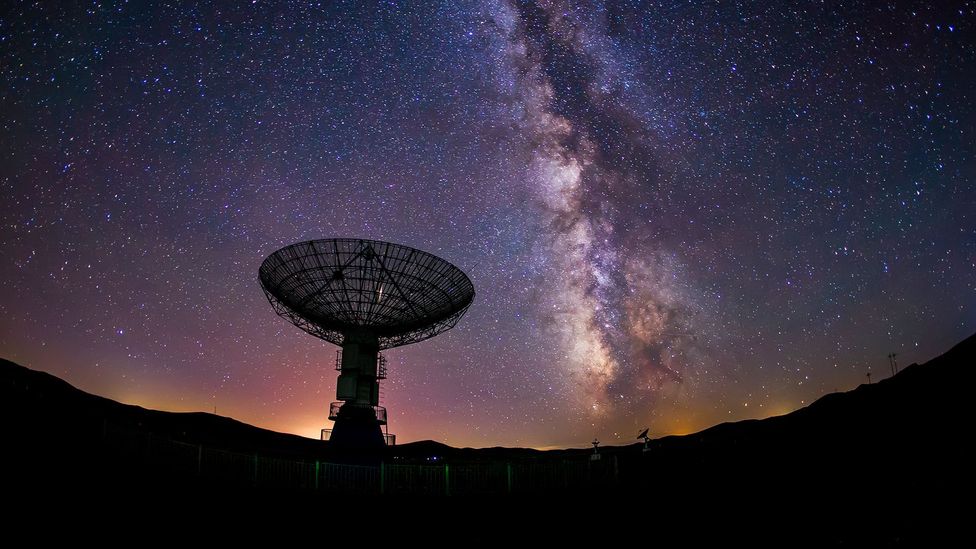But what if there was? And what if they were looking back, trying to find us? Would they know there is life on Earth?
That’s a question scientists have had to grapple with in recent years, as we continue to inadvertently broadcast our presence out into the galaxy. “Hold the mirror up to yourself in space, and what would they see of us?” says Jacqueline Faherty, an astrophysicist at the American Museum of Natural History in the US. “We’re looking. That means other worlds might be looking too.”
To date, we have found more than 5,500 planets orbiting other stars in our galaxy, called exoplanets. But such observations are in their infancy – trillions of worlds are likely scattered throughout the Milky Way. Upon some of these worlds we have started to hunt both for the chemical signatures in their atmospheres that might indicate biological activity and even technosignatures that might be emitted by intelligent life forms – radio signals either purposefully or accidentally sent in our direction.
Earth has been unabashedly broadcasting its own presence into the galaxy for about a century now. The most notable period was from 1900 up to World War Two, says Howard Isaacson, an astronomer at the University of California, Berkeley in the US, when our radio transmissions were stronger. “They needed to be more powerful because the radios that people listened to didn’t have as sensitive receivers,” he says.
We continue to broadcast radio signals today, from TV shows to satellite communications, but in a less detectable way. “Radio stations don’t want to broadcast into space,” says Thomas Beatty, an astronomer at the University of Wisconsin in the US. “They want to broadcast to the ground.” Other more modern forms of communication, like mobile phone signals, are unlikely to be detectable.

The light pollution produced by our cities is visible from the ISS, but is likely not widespread enough to attract the attention of distant alien astronomers (Credit: Nasa/JSC)
But not all of our signals are so faint. Across the Solar System we have multiple spacecraft exploring different locales such as Mars, Jupiter, and even the outer reaches of the Sun. The furthest of these, Nasa’s Voyager 1 spacecraft, is 24 billion kilometres (15 billion miles) from Earth, requiring a powerful network of dishes on Earth known as the Deep Space Network to be communicated with.
In April, Isaacson calculated whether some of these transmissions, up to 20 kilowatts, might reach other stars as they wash over the remote spacecraft and continue their journey into space. He found four nearby stars and any accompanying planets would have already received the transmissions, with more than 1,000 stars likely to hear the signals by the year 2300. “The signal would definitely show up as artificial,” says Isaacson. By 2031, the closest of the stars would have had enough time to receive the signals and send their own message back, perhaps an interesting target for future study.
But what if alien astronomers were more dedicated? They might try and observe our planet before receiving any such signals. If they can see our planet pass in front of our Sun, known as a transit, they could see sunlight passing through our atmosphere and pick out its different gases.
In 2021, Faherty found there were nearly 2,000 stars within 300 light-years of Earth that could potentially be able to see such a transit. “It’s a good haul of worlds,” she says.
The best indicator of life on Earth from such observations might be oxygen, nitrogen, and water vapour, says Paul Rimmer, an astrochemist at the University of Cambridge in the UK, which would “be an indication of a stable liquid ocean”.
You might also like:
- The weird aliens of the 19th Century
- Are aliens real? Here’s what we know
- What life might be like in oceans on other worlds
Nitrogen dioxide could also provide some clues that our planet was inhibited by an intelligent lifeform. The gas is “basically a byproduct of combustion”, says Hector Socas-Navarro, an astrophysicist at the Institute of Astrophysics of the Canary Islands in Spain. “So they might deduce we are burning stuff here.”
Chlorofluorocarbons from aerosols, refrigerants and other sources could also be a give-away sign of industrial activity on our planet. “We’re pretty sure they can only be produced by technology,” says Macy Huston, an astronomer at the University of California, Berkeley in the US. (Read more about how we might also be able to spot alien life from their pollution.)
By 2150 urbanisation might have swelled by 10 times its current levels, and we might then shine like a beacon to modern telescopes
One of the most revealing technosignatures from Earth might not be our atmospheric pollutants or radio signals at all, however, but our city lights. In 2021, Beatty calculated that the sodium emitted from such lights could be detectable in a planet’s atmosphere. “It has very sharp spectral features,” says Beatty. “You’d never get that through a natural process.”
Earth in its current form is likely not urbanised enough to be detectable in such a way, at least within the parameters of our own telescopes. Less than 1% of the Earth’s surface is covered by cities. It’s a long way from being an ecumenopolis – a planet-wide city, similar to the fictional world of Coruscant in the Star Wars films. If development continues at its current pace, however, by 2150 urbanisation might have swelled by 10 times its current levels, and we might then shine like a beacon to modern telescopes, says Beatty.
But alien civilisations with more advanced telescopes might already be able to spot us. “It’s totally feasible that there’s alien astronomers that have built a 100m (330ft) space telescope that could be seeing us right now,” he says.
Even if alien astronomers had a smaller telescope that could only see the faint dot of our planet, they might still be able to work out it is inhabited. Knowing the tilt and rotation of Earth, the light emitted by our planet could be used to make a crude map of our surface, showing land, oceans, and even coastlines, according to Jonathan Jiang, an astrophysicist from Nasa’s Jet Propulsion Laboratory in the US. “As long as you can see a point of light, you can analyse it,” says Jiang, who used a spacecraft in our Solar System in 2018 to demonstrate the technique on Earth.
All of this raises the question of whether we really want to be so noticeable. “In movies we always get invaded,” says Beatty.
In reality, scientists are more eager to make our presence known, occasionally even sending out purposeful messages into the Universe – such as a famous high-powered radio signal containing a simple pictorial on humanity sent by the now-defunct Arecibo radio telescope in Puerto Rico in 1974. “I’m not really worried about Independence Day scenarios,” says Beth Biller, an astronomer at the University of Edinburgh in the UK.

Astronomers use radio telescopes to scan the sky for signals from space, but our own broadcasts could be picked up by similar equipment on other worlds (Credit: Getty Images)
As humanity continues to alter our planet, presuming we don’t end our own existence first through war or other means, Earth is likely to become more and more noticeable. Socas-Navarro says that alien astronomers could even one day spot the cloud of satellites orbiting our planet. We would need to have “a billion times what we have now, which sounds like a lot,” he says. “But we went from one car to over a billion cars in a few decades.”
Perhaps, if we are eager to make first contact, we could do more to make ourselves noticed, such as broadcasts like the Arecibo message. So far, there have only been a handful of further attempts. “If it were just up to me, I’d be broadcasting our existence and hoping someone would answer,” says Rimmer. “But that’s just my opinion. This is a decision that I think should be made globally.”
If the public were in favour, one idea could be to build huge structures in space, says Beatty, such as a large planet-sized triangle or square made of a thin material that would be obviously artificial to alien astronomers. “That would be the main way to get noticed, if we wanted to,” he says.
For the time being, signs of our existence are more modest, but still detectable. “They don’t need miracles,” says Seth Shostak, senior astronomer at the Seti Institute (Search for Extraterrestrial Intelligence) in the US. “They just need the technology we have, but on a larger scale.”
The real question we should ask: is anyone looking our way to notice?














45 comments
I have not checked in here for a while as I thought it was getting boring, but the last few posts are great quality so I guess I?¦ll add you back to my everyday bloglist. You deserve it my friend 🙂
Hi, Neat post. There’s an issue together with your web site in internet explorer, might check thisK IE still is the marketplace leader and a huge element of people will pass over your great writing due to this problem.
I do not even know the way I ended up right here, however I assumed this put up was once good. I do not recognize who you are but definitely you are going to a well-known blogger if you happen to are not already 😉 Cheers!
Lottery Defeater Software is a cutting-edge application designed to analyze and optimize your chances of winning various lottery games.
I genuinely enjoy looking through on this site, it has good posts.
An impressive share, I just given this onto a colleague who was doing a little analysis on this. And he in fact bought me breakfast because I found it for him.. smile. So let me reword that: Thnx for the treat! But yeah Thnkx for spending the time to discuss this, I feel strongly about it and love reading more on this topic. If possible, as you become expertise, would you mind updating your blog with more details? It is highly helpful for me. Big thumb up for this blog post!
I have been absent for a while, but now I remember why I used to love this web site. Thanks, I’ll try and check back more often. How frequently you update your website?
Sweet blog! I found it while searching on Yahoo News. Do you have any suggestions on how to get listed in Yahoo News? I’ve been trying for a while but I never seem to get there! Many thanks
Everything is very open and very clear explanation of issues. was truly information. Your website is very useful. Thanks for sharing.
Nice read, I just passed this onto a colleague who was doing a little research on that. And he just bought me lunch since I found it for him smile So let me rephrase that: Thanks for lunch! “By nature, men are nearly alike by practice, they get to be wide apart.” by Confucius.
Thank you for some other excellent article. The place else may anybody get that type of information in such a perfect method of writing? I’ve a presentation next week, and I am at the search for such info.
Thanks , I’ve recently been searching for information approximately this topic for a long time and yours is the greatest I have discovered till now. However, what about the conclusion? Are you certain in regards to the supply?
What is CogniCare Pro? CogniCare Pro is 100 natural and safe to take a cognitive support supplement that helps boost your memory power. This supplement works greatly for anyone of any age and without side effects
I like this post, enjoyed this one thank you for putting up. “The difference between stupidity and genius is that genius has its limits.” by Albert Einstein.
I really like your writing style, fantastic info, regards for putting up :D. “If a cluttered desk is the sign of a cluttered mind, what is the significance of a clean desk” by Laurence J. Peter.
I like this weblog so much, saved to fav.
I have read a few just right stuff here. Certainly price bookmarking for revisiting. I wonder how much effort you put to make such a fantastic informative site.
I like looking at and I conceive this website got some really utilitarian stuff on it! .
Thanks for every other wonderful article. The place else could anybody get that kind of info in such an ideal way of writing? I’ve a presentation subsequent week, and I am at the look for such information.
I’m not sure where you are getting your information, but good topic. I needs to spend some time learning much more or understanding more. Thanks for fantastic info I was looking for this info for my mission.
I genuinely enjoy studying on this site, it contains fantastic posts.
I truly enjoy looking through on this web site, it has good blog posts.
Sweet blog! I found it while searching on Yahoo News. Do you have any suggestions on how to get listed in Yahoo News? I’ve been trying for a while but I never seem to get there! Thank you
Nice read, I just passed this onto a colleague who was doing a little research on that. And he just bought me lunch since I found it for him smile So let me rephrase that: Thanks for lunch!
You are my inhalation, I possess few blogs and infrequently run out from to post .
F*ckin’ remarkable things here. I’m very satisfied to peer your post. Thank you so much and i’m taking a look forward to contact you. Will you kindly drop me a e-mail?
Appreciate it for this post, I am a big fan of this site would like to keep updated.
You made some decent points there. I looked on the internet for the issue and found most guys will agree with your site.
I am often to running a blog and i really admire your content. The article has actually peaks my interest. I’m going to bookmark your website and preserve checking for brand spanking new information.
Appreciate it for helping out, great information.
I used to be very pleased to search out this web-site.I wished to thanks for your time for this glorious read!! I undoubtedly enjoying every little little bit of it and I have you bookmarked to check out new stuff you blog post.
I’m not sure where you’re getting your info, but great topic. I needs to spend some time learning more or understanding more. Thanks for wonderful info I was looking for this info for my mission.
Hello there, just became aware of your blog through Google, and found that it is truly informative. I am going to watch out for brussels. I’ll be grateful if you continue this in future. A lot of people will be benefited from your writing. Cheers!
I am often to blogging and i really appreciate your content. The article has really peaks my interest. I am going to bookmark your site and keep checking for new information.
I think this website holds very great indited content articles.
Aw, this was a really nice post. In idea I wish to put in writing like this moreover – taking time and precise effort to make a very good article… however what can I say… I procrastinate alot and in no way seem to get something done.
Generally I do not read article on blogs, but I would like to say that this write-up very forced me to try and do it! Your writing style has been amazed me. Thanks, very nice post.
I really like your writing style, great information, thank you for putting up :D. “If a cluttered desk is the sign of a cluttered mind, what is the significance of a clean desk” by Laurence J. Peter.
I am perpetually thought about this, thankyou for putting up.
I got what you mean ,saved to fav, very nice web site.
Hi! I know this is kinda off topic but I was wondering which blog platform are you using for this website? I’m getting sick and tired of WordPress because I’ve had issues with hackers and I’m looking at alternatives for another platform. I would be fantastic if you could point me in the direction of a good platform.
fantastic points altogether, you just gained a new reader. What would you suggest about your post that you made some days ago? Any positive?
You completed some fine points there. I did a search on the matter and found the majority of people will consent with your blog.
Heya are using WordPress for your site platform? I’m new to the blog world but I’m trying to get started and set up my own. Do you need any coding expertise to make your own blog? Any help would be greatly appreciated!
I like the helpful info you provide in your articles. I will bookmark your blog and check again here frequently. I’m quite certain I’ll learn lots of new stuff right here! Best of luck for the next!